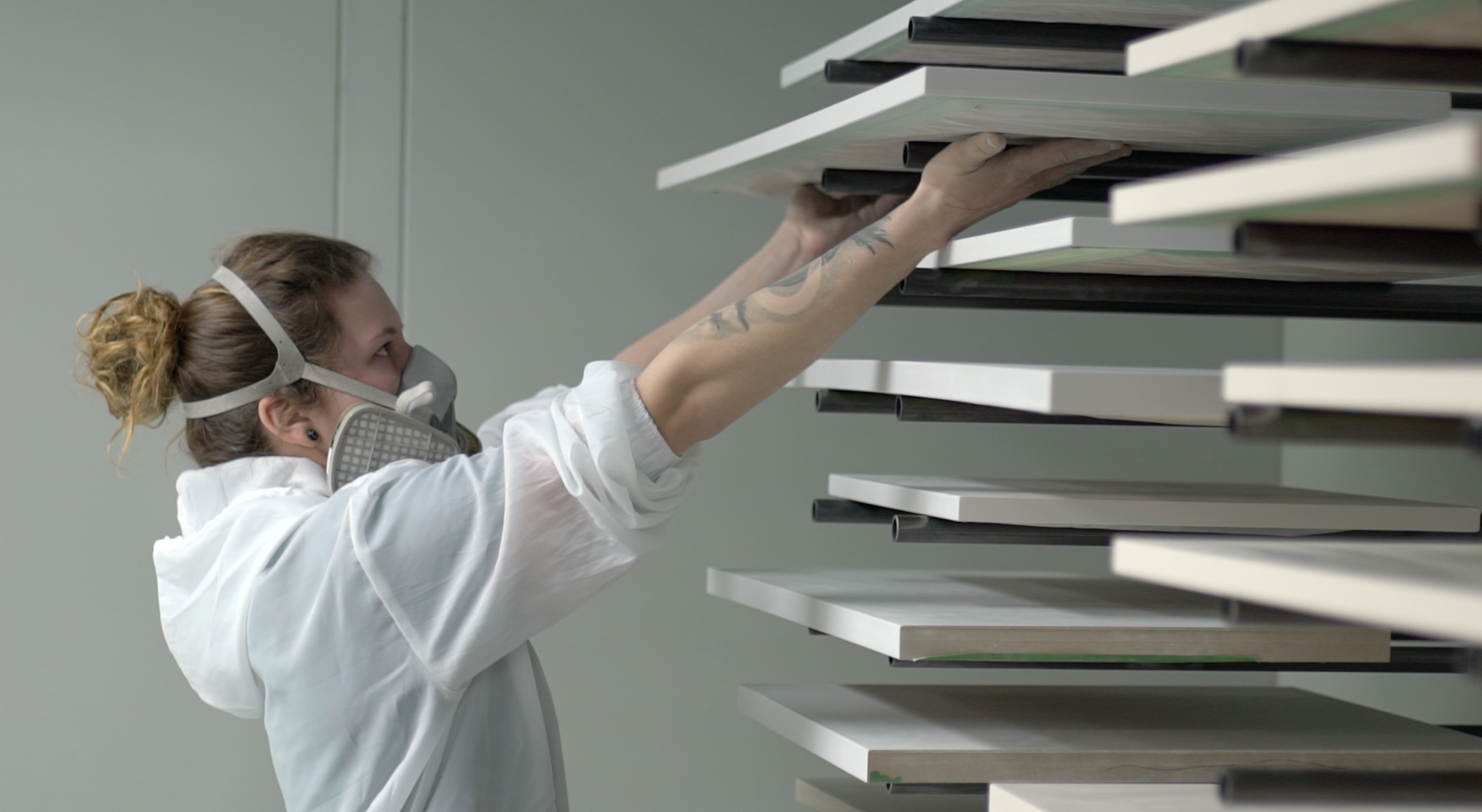LACQUER: AN INFINITE PALETTE OF COLOURS, A TECHNIQUE TO MASTER!
Quality lacquer: How to make the right choice to ensure the longevity of your kitchen cabinets
The Steam Kitchens team meets regularly to explore new trends. In 2025, lacquer is more than ever at the heart of high-end kitchen projects. Deep shades, matte or sandblasted finishes, textured effects: the choice is endless. But before you fall for a trendy color, it's crucial to understand how to choose the right quality lacquer.
Be careful: not all lacquers are created equal. What is important to remember is that the choice of a lacquer color must always be accompanied by an impeccable quality of manufacture. It is this requirement that guarantees the durability and resistance of your kitchen cabinets.
Opting for a low-end or poorly applied lacquer can lead to chipping, tarnishing or scratching problems in the medium term. Conversely, a high-quality, state-of-the-art lacquer ensures not only superior visual appearance, but also exceptional durability.
At Cuisines Steam, each lacquer project is the result of artisanal know-how, combining technique, precision and aesthetic requirements. It is this rigor that makes all the difference, far beyond the simple color.
The secrets of a quality lacquer: from the raw material to the craftsman's hand
The lacquered finish of a kitchen cannot be improvised. Behind an impeccable façade lies true precision work, where every step counts. At Steam Kitchens, we have chosen rigor and excellence at all levels of the process.
1. The choice of material: high-density MDF
It all starts with the basics. For the majority of projects, MDF (Medium Density Fiberboard) is used. But be careful: not all MDF is created equal. We favour high-density panels (HDF), which are more compact, more stable, and better suited to the application of lacquer. This choice guarantees a smooth, uniform surface that is more resistant over time.
2. The lacquer "recipe": a carefully calibrated mixture
As in the kitchen, a good hairspray is based on a well-dosed formula. Our blend includes carefully balanced polyurethane, catalyst and thinner. This technical composition ensures optimal grip, increased resistance and a high-end finish, without compromise.
3. Artisanal know-how, applied by hand
Contrary to what you might think, the application of lacquer is not an automated process. At Steam Kitchens, it is done manually by our specialized painters. Each coat is applied, sanded and controlled with precision. This process, which takes longer than automation, allows us to guarantee consistent, careful and sustainable quality.
Sanding: the key to perfect adhesion and a silky finish
Even before applying the first coat of lacquer, a fundamental job is done: sanding. This step is crucial to properly prepare the parts and ensure optimal adhesion of the coating.
Each panel, each façade is meticulously sanded to:
Eliminate surface imperfections or micro-asperities,
Open the pores of the material (such as HDF), promoting the penetration of the lacquer,
And above all, to create a smooth, uniform base, essential to obtain a high-end, flawless finish.
At Cuisines Steam, sanding is not a simple formality: it is a technical gesture, carried out with care between each layer of lacquer. This intermediate sanding not only corrects any irregularities, but also creates that depth and softness to the touch that makes all the difference.
It is this attention to detail, in the invisible steps, that guarantees an exceptional end result – durable, refined and up to the most demanding expectations.
Masking: a crucial step for a flawless finish
When it comes to quality lacquer, every detail counts — and masking is an integral part of that. Too often neglected, this step consists of precisely protecting the areas that should not receive lacquer, such as the back of the panels, the non-visible edges or certain structural parts.
But his role does not stop there. A well-done masking above all limits the diffusion of spray mist, this microscopic cloud of paint that sometimes settles where it should not be. Without careful masking, this mist can alter the quality of the finish, leading to textural irregularities, such as the dreaded "orange peel" effect — a grainy appearance that breaks the purity of the lacquered finish.
Our teams pay meticulous attention to this step, thus guaranteeing a perfectly smooth, uniform and flawless finish, guaranteeing our signature.
Choosing a lacquered kitchen means opting for a noble, refined and durable finish. But this apparent beauty is based on a series of demanding technical steps: the choice of the right material, a mastered lacquer recipe, rigorous sanding, precise masking, and above all, an artisanal know-how that respects every detail.
🛠️ Pro tip:
If you are comparing different kitchen manufacturers, always ask for the actual number of coats of lacquer applied. Be careful: some so-called "cross" techniques can be counted as two layers, when in reality it is only a single pass. This kind of subtlety can make all the difference in the durability and rigidity of facades.
🛠️ Pro tip:
Take the time to touch surfaces, especially door edges. A high-end lacquer should offer a uniform, soft and perfectly smooth finish, without roughness or graininess. This simple test can tell you a lot about the quality of the sanding and the craftsmanship applied at each stage.
Desire for a kitchen thought out down to the smallest detail ? Trust our team to design a bespoke kitchen that is perfectly suited to your needs, style and space. For more inspiration, take a look at our achievements.













